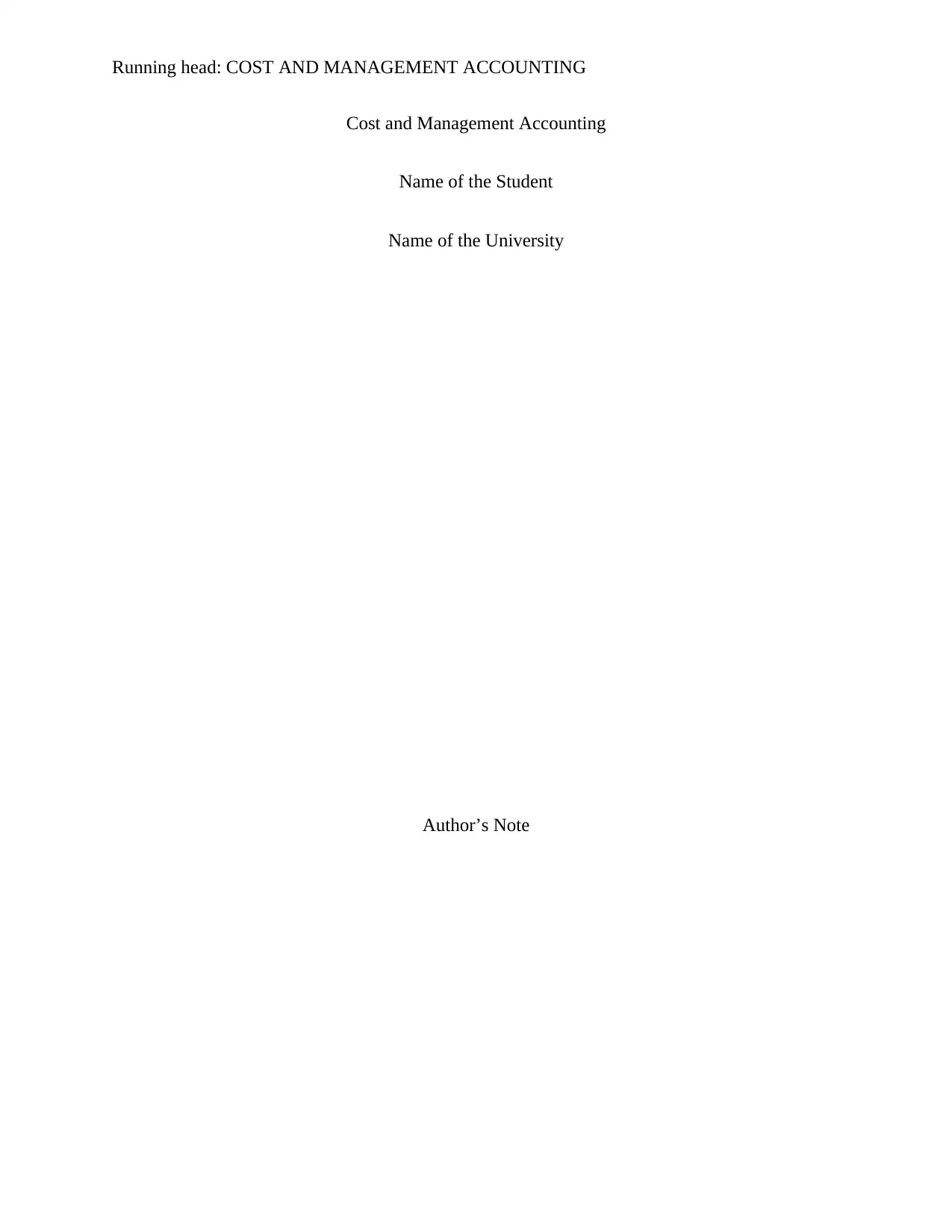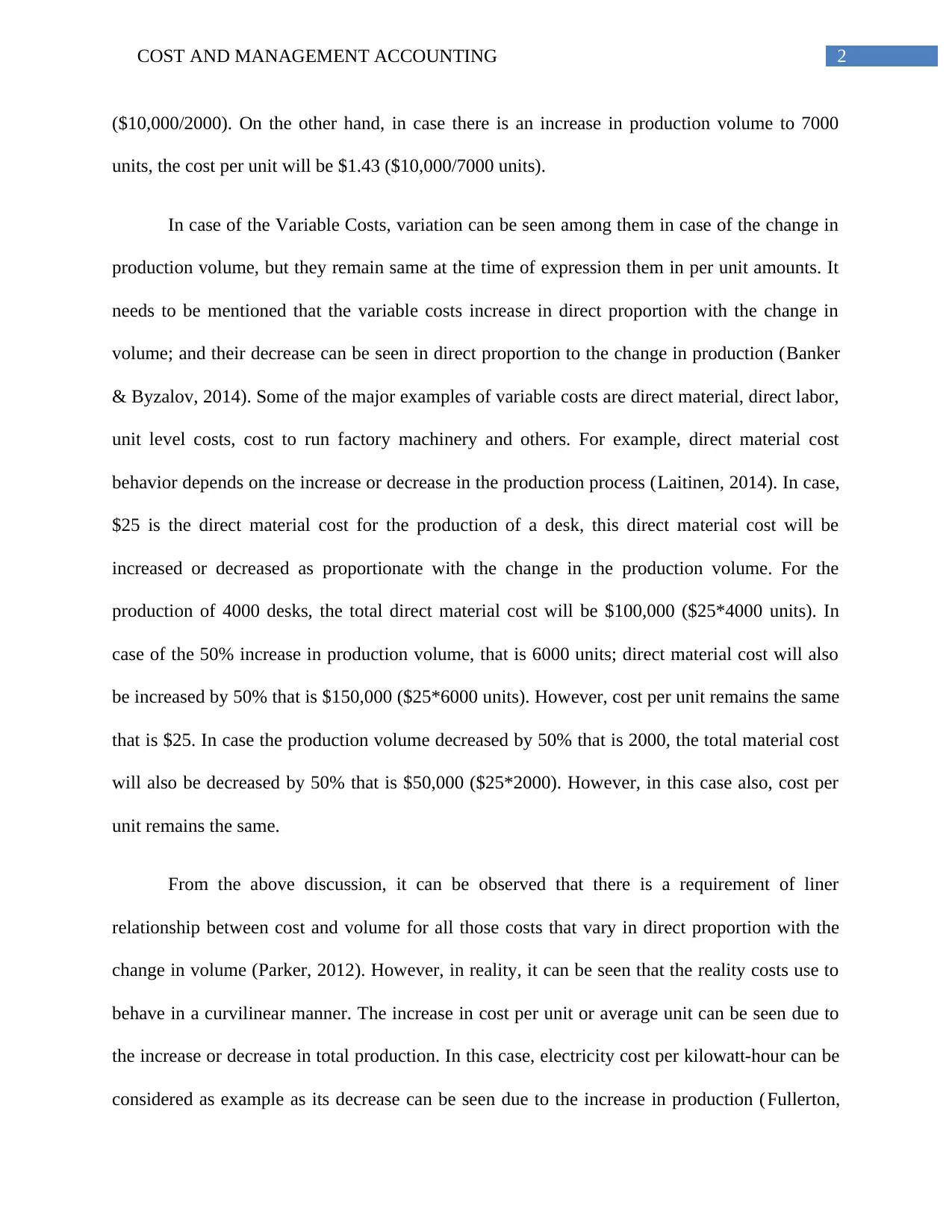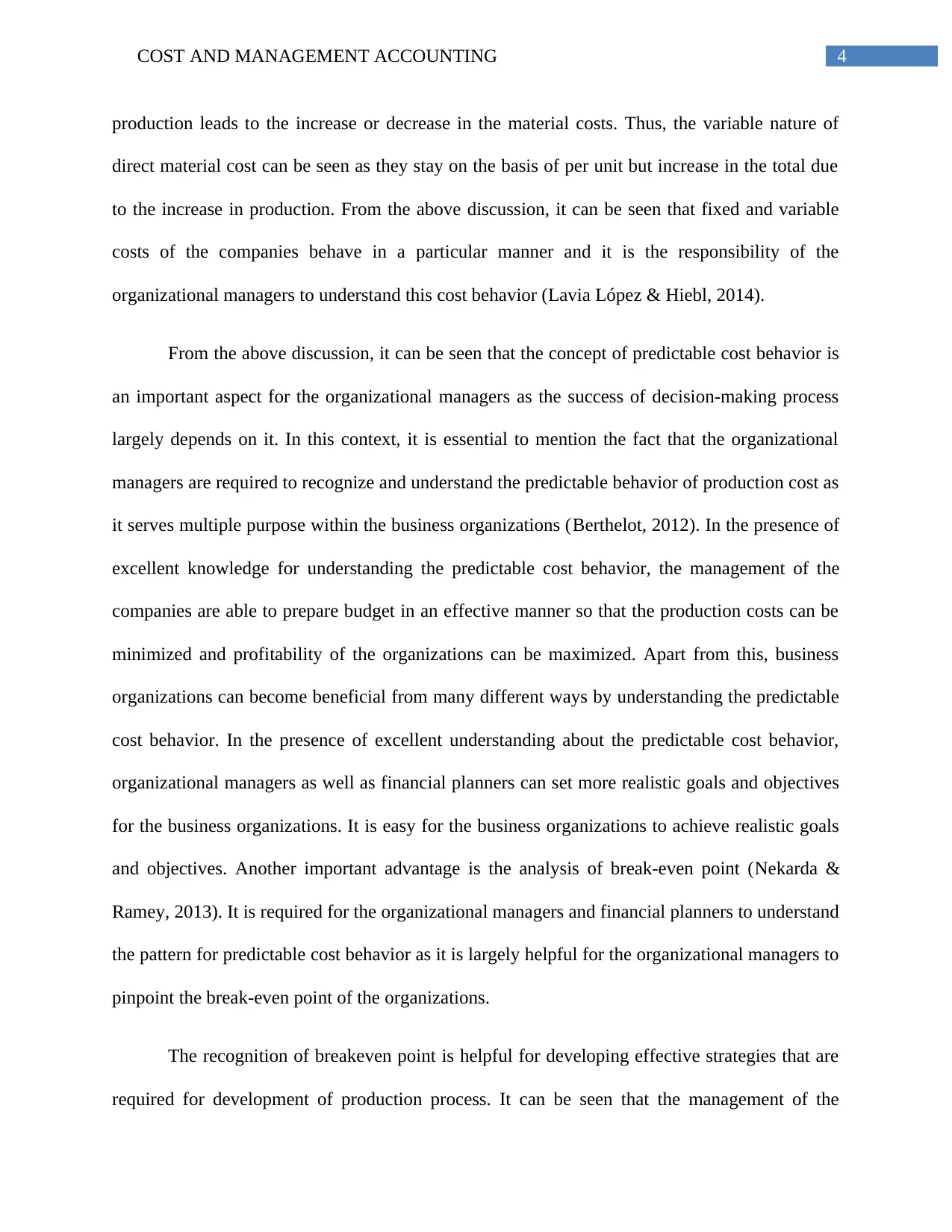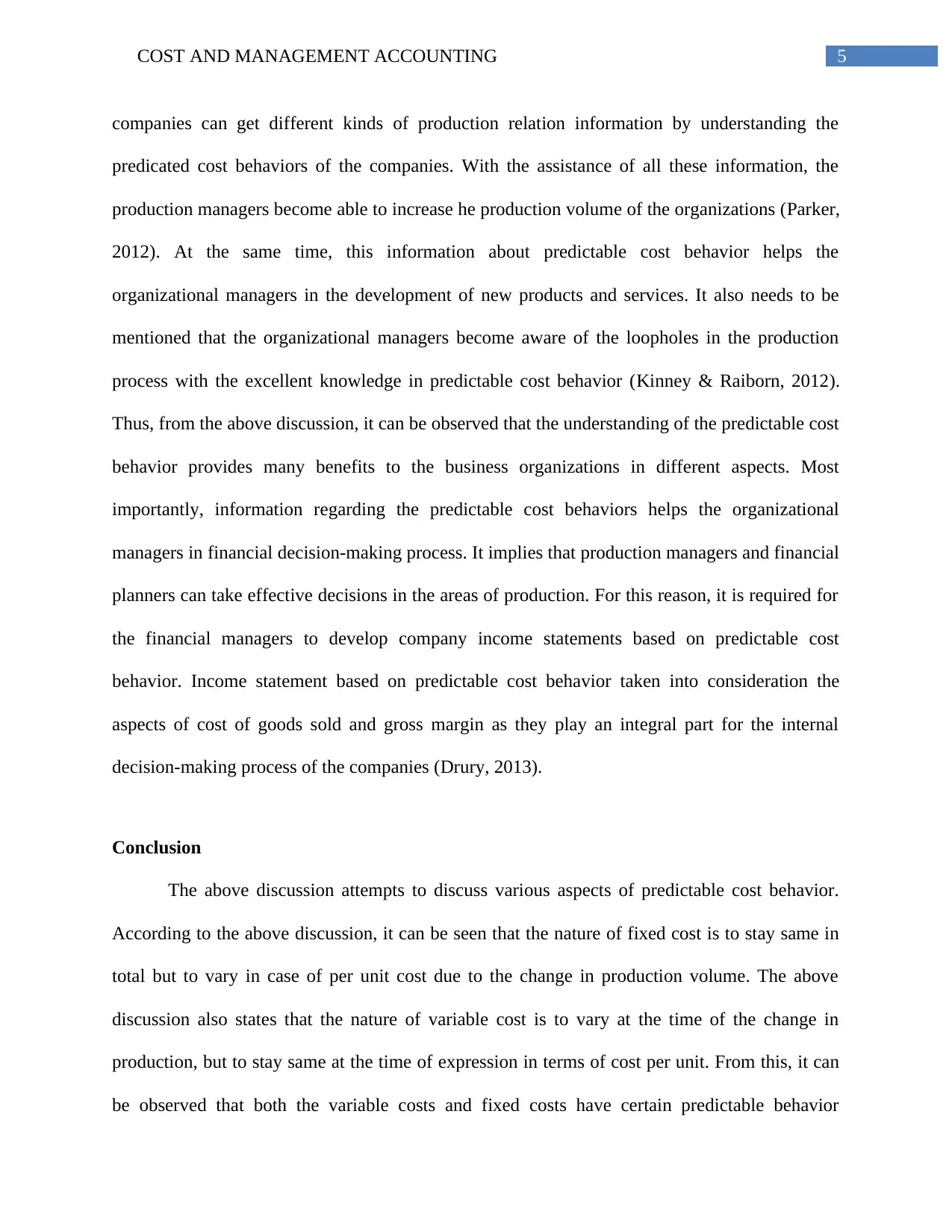Understanding Predictable Cost Behavior in Management Accounting Essay
VerifiedAdded on 2020/05/28
|9
|2187
|51
Essay
AI Summary
This essay delves into the critical importance of understanding predictable cost behavior within cost and management accounting. It examines the behavior of fixed and variable costs, illustrating how they respond to changes in production volume. The essay highlights that fixed costs remain constant in total but vary per unit, while variable costs change proportionally with production. It emphasizes the significance of recognizing these patterns for effective managerial decision-making, including budgeting, setting realistic goals, analyzing break-even points, and developing new products. The essay underscores the need for financial managers to develop income statements based on predictable cost behavior, focusing on the cost of goods sold and gross margin for internal decision-making. The conclusion reinforces the vital role of predictable cost behavior in enhancing profitability, increasing production efficiency, and optimizing overall financial strategies.

Running head: COST AND MANAGEMENT ACCOUNTING
Cost and Management Accounting
Name of the Student
Name of the University
Author’s Note
Cost and Management Accounting
Name of the Student
Name of the University
Author’s Note
Paraphrase This Document
Need a fresh take? Get an instant paraphrase of this document with our AI Paraphraser

1COST AND MANAGEMENT ACCOUNTING
Introduction
In today’s business world, it is necessary for the organizational managers to manage
various business costs in the most effective manner in order to increase the profitability of
business. For this reason, cost management is considered as a crucial part of management
accounting (Drury, 2013). In the production process, two types of cost can be seen; they are
fixed costs and variable cost. The increase and decrease of some costs can be seen due to the
change in volume. However, in the production process, some specific costs can be seen that act
in predictable manner based on the production volume. These are considered as important costs
and the managers are required to take into consideration the effects of these costs as these costs
have the ability of influence the managerial decision-making process (Henri, Boiral & Roy,
2016). This essay aims to establish the importance of the underatsding of predictable cost
behavior for management decision-making process.
Discussion
For establishing the importance of predictable cost behavior, it is important to understand
the behavior of Fixed Costs and Variable Costs. Fixed costs use to remain the same in total, but
variation in them based in per unit can be seen based on the change in production volume
(Kinney & Raiborn, 2012). The examples of some major fixed costs are depreciation, rent, salary
of the production managers, property taxes, insurance and others. Thus, the fixed expenses
remain same in total, but variation on them can be seen when they are expressed in terms of per
unit (Kinney & Raiborn, 2012). For example, rent can be taken into consideration. In case the
rent of a building is $10,000 per annum and the produced units are 5,000, then the per unit rent is
$2 ($10,000/5,000). In case, the production unit becomes 2000, then rent per unit will be $5
Introduction
In today’s business world, it is necessary for the organizational managers to manage
various business costs in the most effective manner in order to increase the profitability of
business. For this reason, cost management is considered as a crucial part of management
accounting (Drury, 2013). In the production process, two types of cost can be seen; they are
fixed costs and variable cost. The increase and decrease of some costs can be seen due to the
change in volume. However, in the production process, some specific costs can be seen that act
in predictable manner based on the production volume. These are considered as important costs
and the managers are required to take into consideration the effects of these costs as these costs
have the ability of influence the managerial decision-making process (Henri, Boiral & Roy,
2016). This essay aims to establish the importance of the underatsding of predictable cost
behavior for management decision-making process.
Discussion
For establishing the importance of predictable cost behavior, it is important to understand
the behavior of Fixed Costs and Variable Costs. Fixed costs use to remain the same in total, but
variation in them based in per unit can be seen based on the change in production volume
(Kinney & Raiborn, 2012). The examples of some major fixed costs are depreciation, rent, salary
of the production managers, property taxes, insurance and others. Thus, the fixed expenses
remain same in total, but variation on them can be seen when they are expressed in terms of per
unit (Kinney & Raiborn, 2012). For example, rent can be taken into consideration. In case the
rent of a building is $10,000 per annum and the produced units are 5,000, then the per unit rent is
$2 ($10,000/5,000). In case, the production unit becomes 2000, then rent per unit will be $5

2COST AND MANAGEMENT ACCOUNTING
($10,000/2000). On the other hand, in case there is an increase in production volume to 7000
units, the cost per unit will be $1.43 ($10,000/7000 units).
In case of the Variable Costs, variation can be seen among them in case of the change in
production volume, but they remain same at the time of expression them in per unit amounts. It
needs to be mentioned that the variable costs increase in direct proportion with the change in
volume; and their decrease can be seen in direct proportion to the change in production (Banker
& Byzalov, 2014). Some of the major examples of variable costs are direct material, direct labor,
unit level costs, cost to run factory machinery and others. For example, direct material cost
behavior depends on the increase or decrease in the production process (Laitinen, 2014). In case,
$25 is the direct material cost for the production of a desk, this direct material cost will be
increased or decreased as proportionate with the change in the production volume. For the
production of 4000 desks, the total direct material cost will be $100,000 ($25*4000 units). In
case of the 50% increase in production volume, that is 6000 units; direct material cost will also
be increased by 50% that is $150,000 ($25*6000 units). However, cost per unit remains the same
that is $25. In case the production volume decreased by 50% that is 2000, the total material cost
will also be decreased by 50% that is $50,000 ($25*2000). However, in this case also, cost per
unit remains the same.
From the above discussion, it can be observed that there is a requirement of liner
relationship between cost and volume for all those costs that vary in direct proportion with the
change in volume (Parker, 2012). However, in reality, it can be seen that the reality costs use to
behave in a curvilinear manner. The increase in cost per unit or average unit can be seen due to
the increase or decrease in total production. In this case, electricity cost per kilowatt-hour can be
considered as example as its decrease can be seen due to the increase in production (Fullerton,
($10,000/2000). On the other hand, in case there is an increase in production volume to 7000
units, the cost per unit will be $1.43 ($10,000/7000 units).
In case of the Variable Costs, variation can be seen among them in case of the change in
production volume, but they remain same at the time of expression them in per unit amounts. It
needs to be mentioned that the variable costs increase in direct proportion with the change in
volume; and their decrease can be seen in direct proportion to the change in production (Banker
& Byzalov, 2014). Some of the major examples of variable costs are direct material, direct labor,
unit level costs, cost to run factory machinery and others. For example, direct material cost
behavior depends on the increase or decrease in the production process (Laitinen, 2014). In case,
$25 is the direct material cost for the production of a desk, this direct material cost will be
increased or decreased as proportionate with the change in the production volume. For the
production of 4000 desks, the total direct material cost will be $100,000 ($25*4000 units). In
case of the 50% increase in production volume, that is 6000 units; direct material cost will also
be increased by 50% that is $150,000 ($25*6000 units). However, cost per unit remains the same
that is $25. In case the production volume decreased by 50% that is 2000, the total material cost
will also be decreased by 50% that is $50,000 ($25*2000). However, in this case also, cost per
unit remains the same.
From the above discussion, it can be observed that there is a requirement of liner
relationship between cost and volume for all those costs that vary in direct proportion with the
change in volume (Parker, 2012). However, in reality, it can be seen that the reality costs use to
behave in a curvilinear manner. The increase in cost per unit or average unit can be seen due to
the increase or decrease in total production. In this case, electricity cost per kilowatt-hour can be
considered as example as its decrease can be seen due to the increase in production (Fullerton,
⊘ This is a preview!⊘
Do you want full access?
Subscribe today to unlock all pages.

Trusted by 1+ million students worldwide

3COST AND MANAGEMENT ACCOUNTING
Kennedy & Widener, 2013). In managerial accounts, the decision-making process of the
managers largely depends on the assumption that there is linear relation between the cost and
volume within the relevant production range. It implies that, as per the managers’ assumption,
the cost per unit uses to remain same over the relevant production range. In this context, relevant
range of products refers to the normal production range that the companies expect to produce for
a particular product. On the other hand, the relevant range can also be considered as a production
volume that establishes the truthfulness of the relationship between fixed and variable costs
(Banerjee, 2012).
Figure 1: Curvilinear Costs and the Relevant Range
(Source: Kinney & Raiborn, 2012)
The link between cost and production can be expressed with the assistance of an
algebraic equation. The equation is as follows:
Y = a + bx
In the above figure, a refers to the point of intersect to (y) axis and b refers to the slope of the
line. The interpretation of the above equation states that one unit decrease or increase in the
Kennedy & Widener, 2013). In managerial accounts, the decision-making process of the
managers largely depends on the assumption that there is linear relation between the cost and
volume within the relevant production range. It implies that, as per the managers’ assumption,
the cost per unit uses to remain same over the relevant production range. In this context, relevant
range of products refers to the normal production range that the companies expect to produce for
a particular product. On the other hand, the relevant range can also be considered as a production
volume that establishes the truthfulness of the relationship between fixed and variable costs
(Banerjee, 2012).
Figure 1: Curvilinear Costs and the Relevant Range
(Source: Kinney & Raiborn, 2012)
The link between cost and production can be expressed with the assistance of an
algebraic equation. The equation is as follows:
Y = a + bx
In the above figure, a refers to the point of intersect to (y) axis and b refers to the slope of the
line. The interpretation of the above equation states that one unit decrease or increase in the
Paraphrase This Document
Need a fresh take? Get an instant paraphrase of this document with our AI Paraphraser

4COST AND MANAGEMENT ACCOUNTING
production leads to the increase or decrease in the material costs. Thus, the variable nature of
direct material cost can be seen as they stay on the basis of per unit but increase in the total due
to the increase in production. From the above discussion, it can be seen that fixed and variable
costs of the companies behave in a particular manner and it is the responsibility of the
organizational managers to understand this cost behavior (Lavia López & Hiebl, 2014).
From the above discussion, it can be seen that the concept of predictable cost behavior is
an important aspect for the organizational managers as the success of decision-making process
largely depends on it. In this context, it is essential to mention the fact that the organizational
managers are required to recognize and understand the predictable behavior of production cost as
it serves multiple purpose within the business organizations (Berthelot, 2012). In the presence of
excellent knowledge for understanding the predictable cost behavior, the management of the
companies are able to prepare budget in an effective manner so that the production costs can be
minimized and profitability of the organizations can be maximized. Apart from this, business
organizations can become beneficial from many different ways by understanding the predictable
cost behavior. In the presence of excellent understanding about the predictable cost behavior,
organizational managers as well as financial planners can set more realistic goals and objectives
for the business organizations. It is easy for the business organizations to achieve realistic goals
and objectives. Another important advantage is the analysis of break-even point (Nekarda &
Ramey, 2013). It is required for the organizational managers and financial planners to understand
the pattern for predictable cost behavior as it is largely helpful for the organizational managers to
pinpoint the break-even point of the organizations.
The recognition of breakeven point is helpful for developing effective strategies that are
required for development of production process. It can be seen that the management of the
production leads to the increase or decrease in the material costs. Thus, the variable nature of
direct material cost can be seen as they stay on the basis of per unit but increase in the total due
to the increase in production. From the above discussion, it can be seen that fixed and variable
costs of the companies behave in a particular manner and it is the responsibility of the
organizational managers to understand this cost behavior (Lavia López & Hiebl, 2014).
From the above discussion, it can be seen that the concept of predictable cost behavior is
an important aspect for the organizational managers as the success of decision-making process
largely depends on it. In this context, it is essential to mention the fact that the organizational
managers are required to recognize and understand the predictable behavior of production cost as
it serves multiple purpose within the business organizations (Berthelot, 2012). In the presence of
excellent knowledge for understanding the predictable cost behavior, the management of the
companies are able to prepare budget in an effective manner so that the production costs can be
minimized and profitability of the organizations can be maximized. Apart from this, business
organizations can become beneficial from many different ways by understanding the predictable
cost behavior. In the presence of excellent understanding about the predictable cost behavior,
organizational managers as well as financial planners can set more realistic goals and objectives
for the business organizations. It is easy for the business organizations to achieve realistic goals
and objectives. Another important advantage is the analysis of break-even point (Nekarda &
Ramey, 2013). It is required for the organizational managers and financial planners to understand
the pattern for predictable cost behavior as it is largely helpful for the organizational managers to
pinpoint the break-even point of the organizations.
The recognition of breakeven point is helpful for developing effective strategies that are
required for development of production process. It can be seen that the management of the

5COST AND MANAGEMENT ACCOUNTING
companies can get different kinds of production relation information by understanding the
predicated cost behaviors of the companies. With the assistance of all these information, the
production managers become able to increase he production volume of the organizations (Parker,
2012). At the same time, this information about predictable cost behavior helps the
organizational managers in the development of new products and services. It also needs to be
mentioned that the organizational managers become aware of the loopholes in the production
process with the excellent knowledge in predictable cost behavior (Kinney & Raiborn, 2012).
Thus, from the above discussion, it can be observed that the understanding of the predictable cost
behavior provides many benefits to the business organizations in different aspects. Most
importantly, information regarding the predictable cost behaviors helps the organizational
managers in financial decision-making process. It implies that production managers and financial
planners can take effective decisions in the areas of production. For this reason, it is required for
the financial managers to develop company income statements based on predictable cost
behavior. Income statement based on predictable cost behavior taken into consideration the
aspects of cost of goods sold and gross margin as they play an integral part for the internal
decision-making process of the companies (Drury, 2013).
Conclusion
The above discussion attempts to discuss various aspects of predictable cost behavior.
According to the above discussion, it can be seen that the nature of fixed cost is to stay same in
total but to vary in case of per unit cost due to the change in production volume. The above
discussion also states that the nature of variable cost is to vary at the time of the change in
production, but to stay same at the time of expression in terms of cost per unit. From this, it can
be observed that both the variable costs and fixed costs have certain predictable behavior
companies can get different kinds of production relation information by understanding the
predicated cost behaviors of the companies. With the assistance of all these information, the
production managers become able to increase he production volume of the organizations (Parker,
2012). At the same time, this information about predictable cost behavior helps the
organizational managers in the development of new products and services. It also needs to be
mentioned that the organizational managers become aware of the loopholes in the production
process with the excellent knowledge in predictable cost behavior (Kinney & Raiborn, 2012).
Thus, from the above discussion, it can be observed that the understanding of the predictable cost
behavior provides many benefits to the business organizations in different aspects. Most
importantly, information regarding the predictable cost behaviors helps the organizational
managers in financial decision-making process. It implies that production managers and financial
planners can take effective decisions in the areas of production. For this reason, it is required for
the financial managers to develop company income statements based on predictable cost
behavior. Income statement based on predictable cost behavior taken into consideration the
aspects of cost of goods sold and gross margin as they play an integral part for the internal
decision-making process of the companies (Drury, 2013).
Conclusion
The above discussion attempts to discuss various aspects of predictable cost behavior.
According to the above discussion, it can be seen that the nature of fixed cost is to stay same in
total but to vary in case of per unit cost due to the change in production volume. The above
discussion also states that the nature of variable cost is to vary at the time of the change in
production, but to stay same at the time of expression in terms of cost per unit. From this, it can
be observed that both the variable costs and fixed costs have certain predictable behavior
⊘ This is a preview!⊘
Do you want full access?
Subscribe today to unlock all pages.

Trusted by 1+ million students worldwide

6COST AND MANAGEMENT ACCOUNTING
associated with the production volume and cost per unit. In addition, from the above discussion,
it can also be seen that having excellent knowledge in predictable cost behavior helps the
business organizations in various aspects like increase in profitability, increase in production,
redaction costs and others. Thus, based on the whole study, it can be concluded that the concept
of predictable cost behavior based on volume has major importance for managerial decision-
making process.
associated with the production volume and cost per unit. In addition, from the above discussion,
it can also be seen that having excellent knowledge in predictable cost behavior helps the
business organizations in various aspects like increase in profitability, increase in production,
redaction costs and others. Thus, based on the whole study, it can be concluded that the concept
of predictable cost behavior based on volume has major importance for managerial decision-
making process.
Paraphrase This Document
Need a fresh take? Get an instant paraphrase of this document with our AI Paraphraser

7COST AND MANAGEMENT ACCOUNTING
References
Banerjee, B. (2012). Financial policy and management accounting. PHI Learning Pvt. Ltd..
Banker, R. D., & Byzalov, D. (2014). Asymmetric cost behavior. Journal of Management
Accounting Research, 26(2), 43-79.
Berthelot, J. M. (2012). Composite materials: mechanical behavior and structural analysis.
Springer Science & Business Media.
DRURY, C. M. (2013). Management and cost accounting. Springer.
Fullerton, R. R., Kennedy, F. A., & Widener, S. K. (2013). Management accounting and control
practices in a lean manufacturing environment. Accounting, Organizations and
Society, 38(1), 50-71.
Henri, J. F., Boiral, O., & Roy, M. J. (2016). Strategic cost management and performance: The
case of environmental costs. The British Accounting Review, 48(2), 269-282.
Kinney, M. R., & Raiborn, C. A. (2012). Cost accounting: Foundations and evolutions. Cengage
Learning.
Kinney, M. R., & Raiborn, C. A. (2012). Cost accounting: Foundations and evolutions. Cengage
Learning.
Laitinen, E. K. (2014). Influence of cost accounting change on performance of manufacturing
firms. Advances in Accounting, 30(1), 230-240.
References
Banerjee, B. (2012). Financial policy and management accounting. PHI Learning Pvt. Ltd..
Banker, R. D., & Byzalov, D. (2014). Asymmetric cost behavior. Journal of Management
Accounting Research, 26(2), 43-79.
Berthelot, J. M. (2012). Composite materials: mechanical behavior and structural analysis.
Springer Science & Business Media.
DRURY, C. M. (2013). Management and cost accounting. Springer.
Fullerton, R. R., Kennedy, F. A., & Widener, S. K. (2013). Management accounting and control
practices in a lean manufacturing environment. Accounting, Organizations and
Society, 38(1), 50-71.
Henri, J. F., Boiral, O., & Roy, M. J. (2016). Strategic cost management and performance: The
case of environmental costs. The British Accounting Review, 48(2), 269-282.
Kinney, M. R., & Raiborn, C. A. (2012). Cost accounting: Foundations and evolutions. Cengage
Learning.
Kinney, M. R., & Raiborn, C. A. (2012). Cost accounting: Foundations and evolutions. Cengage
Learning.
Laitinen, E. K. (2014). Influence of cost accounting change on performance of manufacturing
firms. Advances in Accounting, 30(1), 230-240.

8COST AND MANAGEMENT ACCOUNTING
Lavia López, O., & Hiebl, M. R. (2014). Management accounting in small and medium-sized
enterprises: current knowledge and avenues for further research. Journal of Management
Accounting Research, 27(1), 81-119.
Nekarda, C. J., & Ramey, V. A. (2013). The cyclical behavior of the price-cost markup (No.
w19099). National Bureau of Economic Research.
Parker, L. D. (2012). Qualitative management accounting research: Assessing deliverables and
relevance. Critical perspectives on accounting, 23(1), 54-70.
Vanderbeck, E. J. (2012). Principles of cost accounting. Cengage Learning.
Lavia López, O., & Hiebl, M. R. (2014). Management accounting in small and medium-sized
enterprises: current knowledge and avenues for further research. Journal of Management
Accounting Research, 27(1), 81-119.
Nekarda, C. J., & Ramey, V. A. (2013). The cyclical behavior of the price-cost markup (No.
w19099). National Bureau of Economic Research.
Parker, L. D. (2012). Qualitative management accounting research: Assessing deliverables and
relevance. Critical perspectives on accounting, 23(1), 54-70.
Vanderbeck, E. J. (2012). Principles of cost accounting. Cengage Learning.
⊘ This is a preview!⊘
Do you want full access?
Subscribe today to unlock all pages.

Trusted by 1+ million students worldwide
1 out of 9
Related Documents
Your All-in-One AI-Powered Toolkit for Academic Success.
+13062052269
info@desklib.com
Available 24*7 on WhatsApp / Email
![[object Object]](/_next/static/media/star-bottom.7253800d.svg)
Unlock your academic potential
Copyright © 2020–2025 A2Z Services. All Rights Reserved. Developed and managed by ZUCOL.




